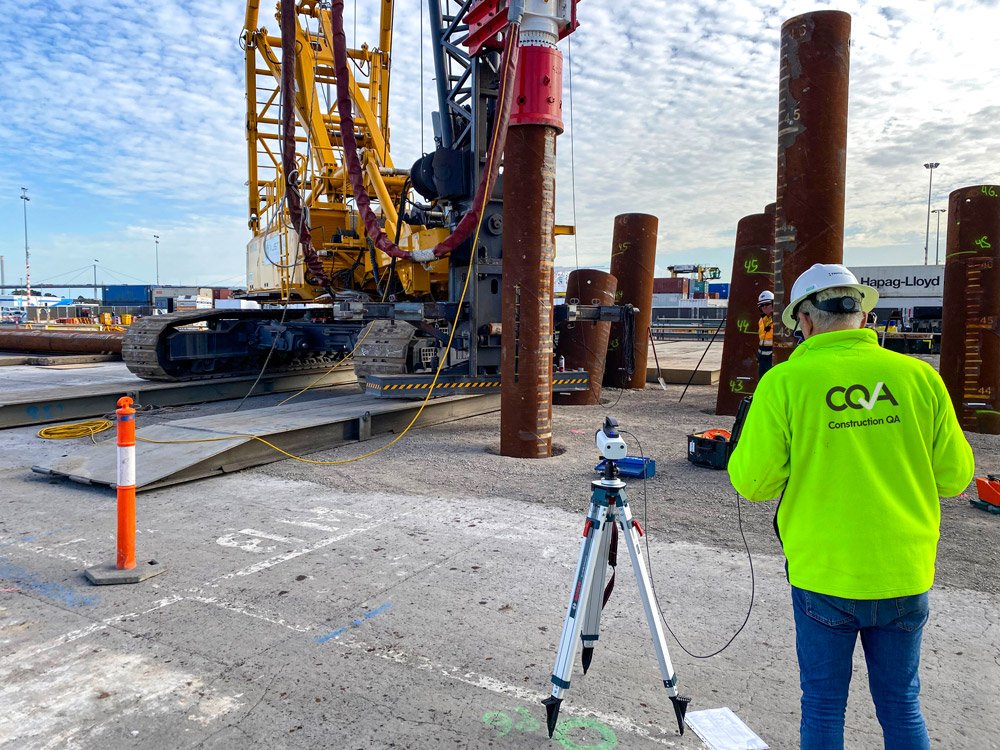
Driven Pile Acceptance
How many piles should be tested?
How many piles of a piling project should be tested to be assured of the quality of that project? The provided answers to this critical question were mainly limited by the number of piles that practically could be tested in each technological age during piling history. The first serious answer to the question was provided decades ago when the advances in mechanical technology allowed engineers to use hydraulic power to load the piles down while measuring their settlements. Pile Static Load Testing (SLT) was the first scientific method that practically allowed engineers to evaluate the actual behavior of a pile under real loading conditions. But, the test was so difficult, time-consuming, and expensive that practically only 0.5% to 1% of the piles could have been tested by static loading. Then in the 90’s, Dynamic Load Testing was introduced to the market by Pile Dynamics Inc which revolutionized the piling industry by allowing engineers to test 5-15% of piles without imposing huge costs or delays to the project. PDA (Pile Driving Analyzer) highly improved the quality control of piling projects but even with PDA, 85% to 95% of the piles remain untested.
Every Pile Matters!
Technically, every single pile on a project should function according to the design specification. So, testing 15% of the piles of a project, while the insufficient pile(s) could potentially be between the 85% non-tested piles, would not assure the quality of a piling project. As a consequence, greater safety factors (or smaller reduction factors) must be used to cover this uncertainty. Hence, if practical and economically justifiable, a foundation engineer prefers 100% of the piles being tested. But are there fast, cheap, and accurate methods that allow all piles to be tested? fortunately for driven piles, the answer to this question is positive.
Pile Driving Formulae
From the beginning of pile driving history, engineers were tempted to translate blow numbers per certain value of penetration to the pile capacity. These efforts ended in many different equations which are called “pile driving formulae”. Within tens of known equations, Hiley’s formula which based its capacity calculation on the measurement of permanent penetration per blow (Set) and Temporary compression (TC), is very well accepted. But the usage of the original Hiley formula had limitations listed below which prevented it from being reliably used for evaluating the capacity of untested piles:
Manual measurement of Set and TC was inaccurate and unsafe.
There were errors in the estimation of energy transferred to the pile.
Hiley's formula provides “resistance to driving”, which is a combination of static and dynamic capacities, while the engineer is interested in the pile “static capacity” only.
Pile Driving Monitor; PDM³
Through his four decades of involvement in hundreds of iconic projects, Dr. Julian Seidel felt the need for a method that could reliably evaluate the capacity of every single pile in a pile-driving project, without imposing reasonable cost or delay to the construction process. According to his idea, Heily's formula had the potential to respond to this need. So he focused on the limitations above and came up with a solution which is named PDM³ (Pile Driving Monitor).
Thanks to its accurate non-contact optical technology, PDM³ is able to measure Set and TC safely with 0.1 mm accuracy. It only needs the placement of small reflectors on a pile which takes less than a minute.
In order to fix the energy error, PDM³ uses average EMX from PDA data acquired from the 5-15% dynamically tested piles.
A Dynamic Reduction Factor (DRF) will be calculated based on the comparison of the Heily formula and CAPWAP results, to be applied to the outputs from untested piles and report static capacity.
The combination of PDM³ and PDA allows for 100% approval of the piles in a pile-driving project.
Visit the PDM³ product page for more information.



